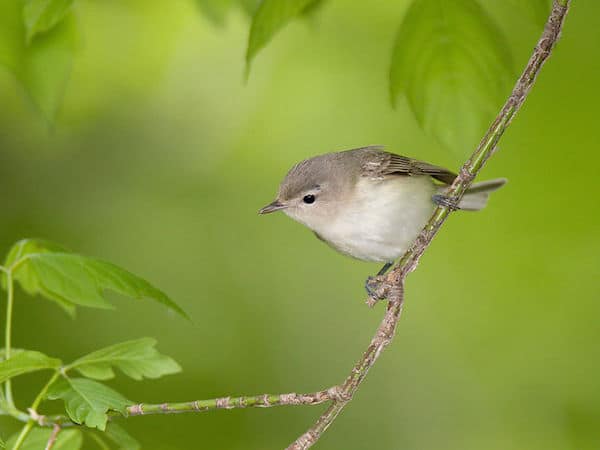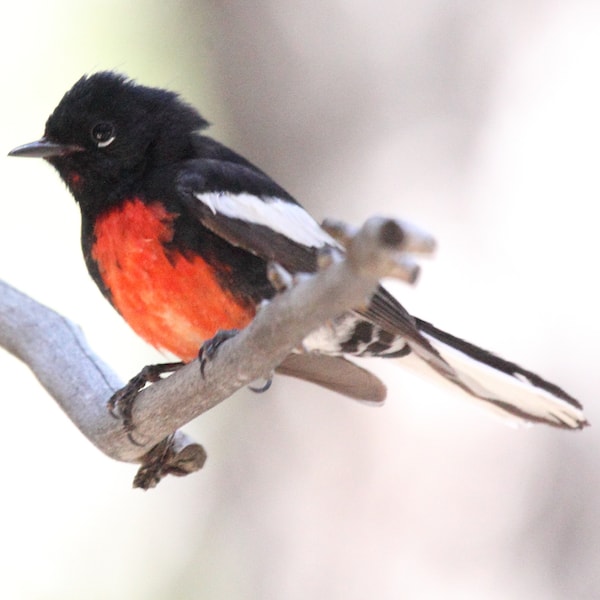Despite its name, the nighthawk is not a hawk and is active both day and night. The common nighthawk is a long-winged, dark bird with characteristic white wing slashes. Its distinctive bounding flight helps to identify it from a distance as it forages over fields, towns, and woods. Nighthawks belong to the goatsucker family, a name based on the old myth that they drank milk from livestock at night.
Listen for
Flying nighthawks utter a sharp, nasal call: beeertt! Males performing their courtship flight dive from a great height, making a deep, booming noise with their wings.
Find it
A common breeding bird throughout North America, nighthawks can be seen in flight over almost any habitat. In cities and towns, night-hawks are attracted to the insects around streetlamps. Beginning in late July, nighthawks gather at dusk in large migratory flocks, sometimes numbering dozens of birds. During the winter, night-hawks reside in South America, returning to the southern United States by early April.
What Does a Common Nighthawk Eat?
A specialist in catching flying insects, the common nighthawk’s mouth opens wide to capture its prey. The nighthawk sees its prey—most often flying ants, beetles, moths, and mayflies—and pursues and catches it. When a nighthawk needs water, it swoops low over a lake or river and skims a drink from the surface.
Nesting Behavior
Historically, nighthawk nests were found on the ground in grasslands and in open patches of soil, gravel, or sand. The nest is a shallow depression near a log or stone that helps to shade and conceal it. Now, nighthawk nests are more commonly found on gravel roads or on flat, gravel-covered rooftops in urban areas.
The female selects the nest site, lays two eggs, and handles the 18-day incubation. She also broods young highthawks for 15 days, protecting them from sun and weather. Meanwhile, the male feeds both his mate and the young in the nest. After 20 days, the young birds are able to fly, and the male then takes over their care while the female starts a second nest.
WOW!
Nighthawks are members of the goatsucker family, which got its name from the belief that these birds sucked milk or blood from goats and other livestock. However, these birds only eat insects and drink water.
Listen to the common nighthawk:





7/17/16: Guess I’m the first one to post a comment for this species.
I live in Louisa County (Central Virginia, between Charlottesville and Richmond). This is a very rural county. Between my property and the immediate surrounding farms, there are perhaps 3 houses on 1,500 acres. In addition to agricultural and horse farms, much of it is wooded/overgrown. My house sits on a 7 acre clearing well off the paved road. There are a couple of small ponds on the farms, but no large bodies of water around here.
Two evenings ago I heard the grunt of the Common Nighthawk near my house and had absolutely no idea what the heck it was. My first thought was that a large bird of some type had been injured and was suffering. I searched but was unable to find anything.
I have heard the same grunts in the mornings and again in the late afternoons/evenings but have yet to see the source of the sounds. A long internet search (“what bird sounds like frogs/pigs”) led me to a site that had some suggestions, one of which was the common nighthawk. A further search led me to a site that has 4 different Nighthawk calls, to include the grunt.
I arrived here in an effort to learn more about the behaviour of these birds in my area. I see that they are migratory and wonder how much longer they may be here…there is a broad range of arrival/departure dates cited for North America. I am also trying to figure out how to see these darned things. I got out this evening and tried to see if I could spot them feeding, but no luck. I have heard the grunts come from three entirely different spots at the edge of the cleared area. I don’t have an exterior light to attract bugs. I used to have a “dusk to dawn” streetlight, and loved watching the bats, but I had it disconnected so that I could better use my telescope.
I’ve (carefully) walked around where I think I heard them, looking for eggs, but found none. I have tons of different birds here–with lots of different types of feeders set up throughout my property–and would love to add these guys to my “spotted” list.
So, can anyone tell me:
-Roughly what date range can I expect these to be around my geography (arrival/departure)?
-Any suggestions on how to find/view them?
-I have never noticed them before (been bird watching here 6 years). Have I just overlooked them, or do they not habituated the same spots year after year? In other words, what is the likelihood that I shall have nighthawks visit again in future years?
Thanks!
Hi BillVA,
Nighthawks head south in late September; by October, they’re pretty much gone from our latitude. During migration, it’s possible to spot flocks of them during the day. Look for sleek, elegant looking birds with a white rectangle on their wings. The biggest flock I’ve seen during migration is 12, but I’ve seen several smaller flocks, always in September, and often flying pretty high. You won’t find any nests or eggs now—it’s too late in the summer. They’ve probably been nesting on flat roofs, or gravel stream banks, or flat rock outcroppings in your area, but the easiest way to see them is to go to town at night, or to a shopping center parking lot; listen for their BRRRZT call as they flit like moths, foraging for moths and other flying insects around lights. I got my life (first ever) night hawk at a K-mart parking lot. I’d say odds are good that they’ll nest in your area next year, but I’ve never seen a nighthawk nest. Here in Marietta, Ohio, nighthawks are common downtown at dusk and dawn, and even though I live in the city, I see them frequently. (I hear them, then I see them.) They’re still here, and still calling, as of late July. Nighthawks are on a serious decline, though, so each year, they are harder to find. I hope they do return to your neighborhood next year, and mine, too. –Dawn Hewitt, Bird Watcher’s Digest